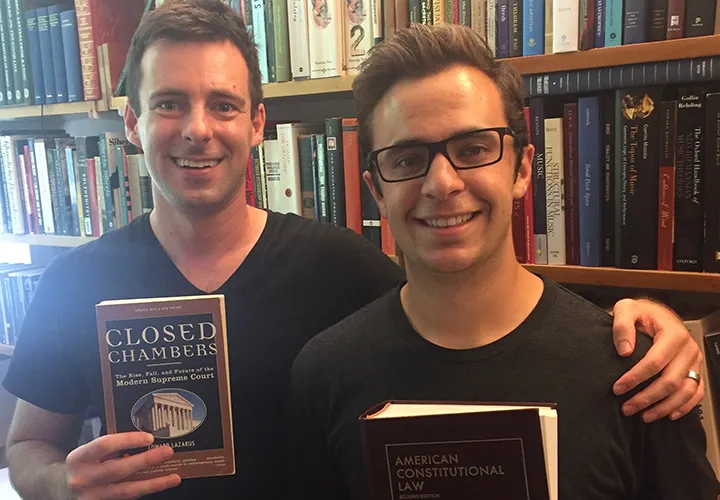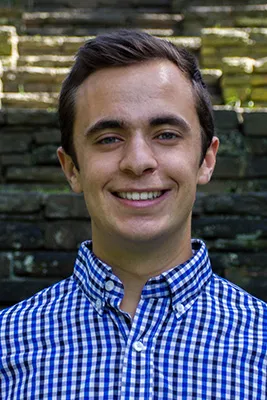NSF Grant Allows Mathematician Noah Giansiracusa to Study the Poetry of Pure Math

Assistant Professor of Mathematics and Statistics Noah Giansiracusa and Cameron Ricciardi '19 collaborated on a paper that surveys the ways in which geometry appears in legal and political settings.
Noah Giansiracusa, assistant professor of mathematics and statistics, is the recipient of a National Science Foundation (NSF) grant to study matroids. The $165,000 grant over three years covers research travel expenses, provides summer student stipends, and funds an outreach program aimed at recruiting more students in mathematics from disadvantaged backgrounds.
To grasp the concept of a matroid, it helps to begin with a matrix—a universal way of encoding data in mathematics, computer science, engineering, statistics, and other subjects. Giansiracusa’s research aims to bring powerful tools and concepts from geometry to bear on long-standing theoretical questions about matroids.
But matroids require some really radical thinking. “It is a method first introduced in 1935, where we don’t say exactly what data is stored in the matrix and instead we merely specify the rules that data should satisfy,” says Giansiracusa.
This means we have things that look, act, and smell like they come from data, he says, even in the absence of actual data. The concept is a bit like imaginary numbers, explains Giansiracusa, which behave like numbers even though they don’t exist as real numbers.
“Matroids have proven to be a powerful way of studying various data-like structures that appear in many areas of mathematics and the natural sciences,” he says. In pure mathematics, as opposed to applied, the work mathematicians do is generally guided by aesthetics, rather than utility, says Giansiracusa. “We are not trying to build a model of a real-world phenomenon, or an algorithm for predicting some quantity of interest to non-mathematicians,” he says. “We are simply trying to uncover a little piece of a (hopefully) beautiful story that lives in the shared imaginations of mathematicians around the world.

Cameron Ricciardi ‘19 wrote two papers with Giansiracusa and plans to attend law school after graduation.
“I like to think of each piece of pure mathematics we create as a poem,” he says, “something people find elegant due to the way ideas are captured using an uncommon language—ideas that would be nearly impossible to convey in ordinary everyday spoken terms.”
One element that lends beauty to both mathematics and poetry, he says, is when seemingly unrelated stories are united in unexpected ways. “That’s the main emphasis of my current project,” he says, “to use ideas from one area of pure mathematics, geometry, to study problems in another area, matroid theory.”
In addition to supporting his research, the NSF grant encourages community outreach, an important component of a Swarthmore education. Giansiracusa is particularly excited about an outreach activity he designed for this grant that involves bringing students from neighboring Chester High School for a four-day summer enrichment program focusing on interactions between mathematics and law.
This program aims to provide an opportunity for students who don’t typically think of themselves as “math types.”
“It shows them that math is all around us in the real world and that everyone can contribute to understanding and using it, and to preventing the misuse of it,” he says. Though it’s small, Giansiracusa is hopeful the program will help to provide a nontraditional pathway to mathematics that reaches beyond the standard recruitment paths, such as math competitions.
Helping Giansiracusa organize and run this math-and-law high school program is Cameron Ricciardi ’19, an economics and mathematics double major from Media, Pa., who worked last year on a research project on a related topic.
“Professor Giansiracusa and I collaborated on a paper in which we surveyed various ways in which geometry shows up in legal and political settings,” says Ricciardi. “We include examples that involve legal theory, cartography, criminal law, and redistricting. These examples reveal that mathematics and law operate in similar ways through logical reasoning, but they differ in that mathematics seeks precision whereas law relies on vagueness and subjective interpretation.”
Giansiracusa and Ricciardi also wrote a research paper using ideas from planar geometry to study voting patterns on the U.S. Supreme Court. They originally planned it for a mathematical audience, but recently, a political science professor at Yale took an interest in the paper and is helping them rewrite it so that it translates to the political science community.
“We’re both really excited about this,” says Giansiracusa. “For Cameron, it’s ideal since he plans to attend law school after graduating, and for me, who works primarily as a pure mathematician, it is quite a new experience to use mathematics - especially geometry, an abstract subject I love - to provide new insight into a field that ostensibly has nothing to do with mathematics.” While these legal projects are not related to matroids, Giansiracusa is excited to be able to work closely with Swarthmore students on these two topics and to receive this significant financial support from the NSF.
To learn more about how Swarthmore is investing in its vibrant intellectual culture, visit lifechanging.swarthmore.edu.



